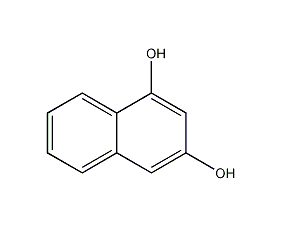
Structural formula
| Business number | 03NS |
|---|---|
| Molecular formula | C10H8O2 |
| Molecular weight | 160.17 |
| label |
1,3-Naphthalenediol, Naphthoresorbinol, aromatic compounds |
Numbering system
CAS number:132-86-5
MDL number:MFCD00003965
EINECS number:205-079-7
RTECS number:QJ4725000
BRN number:2044002
PubChem number:24897775
Physical property data
None yet
Toxicological data
Mutagenicity data:
Bacteria–Salmonella typhimurium: 250umol/L
Bacteria–Salmonella typhimurium: 625nmol/plate
Ecological data
None yet
Molecular structure data
5. Molecular property data:
1、 Molar refractive index:47.85
2、 Molar volume(m3/mol) :120.4
3、 Isotonic specific volume(90.2K):341.1
4、 Surface tension(3.0 dyne/cm):64.4
5、 Polarizability0.5 10-24 cm3):18.97
Compute chemical data
1. Reference value for hydrophobic parameter calculation (XlogP): None
2. Number of hydrogen bond donors: 2
3. Number of hydrogen bond acceptors: 2
4. Number of rotatable chemical bonds: 0
5. Number of tautomers: 15
6. Topological molecule polar surface area 40.5
7. Number of heavy atoms: 12
8. Surface charge: 0
9. Complexity: 158
10. Number of isotope atoms: 0
11. Determine the number of atomic stereocenters: 0
12. Uncertain number of atomic stereocenters: 0
13. Determine the number of chemical bond stereocenters: 0
14. Number of uncertain chemical bond stereocenters: 0
15. Number of covalent bond units: 1
Properties and stability
basic properties
Pink to yellow leaf-like crystals. Melting point 124-125℃, easily soluble in water, alcohol and ether.
Storage method
None yet
Synthesis method
Brief description of production methods
Decarboxylated from 1,3-dihydroxy-2-naphthoic acid
Purpose
Purpose
Sugar and oil reagent for measuring glucuronic acid in urine.
t-font-family: Arial; mso-font-kerning: 0pt”>(0.5 10 -24cm3):18.97
Compute chemical data
1. Reference value for hydrophobic parameter calculation (XlogP): None
2. Number of hydrogen bond donors: 2
3. Number of hydrogen bond acceptors: 2
4. Number of rotatable chemical bonds: 0
5. Number of tautomers: 15
6. Topological molecule polar surface area 40.5
7. Number of heavy atoms: 12
8. Surface charge: 0
9. Complexity: 158
10. Number of isotope atoms: 0
11. Determine the number of atomic stereocenters: 0
12. Uncertain number of atomic stereocenters: 0
13. Determine the number of chemical bond stereocenters: 0
14. Number of uncertain chemical bond stereocenters: 0
15. Number of covalent bond units: 1
Properties and stability
basic properties
Pink to yellow leaf-like crystals. Melting point 124-125℃, easily soluble in water, alcohol and ether.
Storage method
None yet
Synthesis method
Brief description of production methods
Decarboxylated from 1,3-dihydroxy-2-naphthoic acid
Purpose
Purpose
Sugar and oil reagent for measuring glucuronic acid in urine.

 微信扫一扫打赏
微信扫一扫打赏

